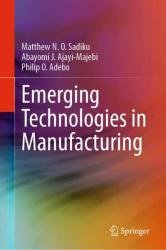 Название: Emerging Technologies in Manufacturing
Название: Emerging Technologies in ManufacturingАвтор: Matthew N. O. Sadiku, Abayomi J. Ajayi-Majebi, Philip O. Adebo
Издательство: Apress
Год: 2023
Страниц: 297
Язык: английский
Формат: pdf (true), epub
Размер: 49.3 MB
The manufacturing industry is a cornerstone of national economy and people’s livelihood. It is the way of transforming resources into products or goods which are required to cater to the needs of the society. Traditional manufacturing companies currently face several challenges such as rapid technological changes, inventory problem, shortened innovation, short product life cycles, volatile demand, low prices, highly customized products, and ability to compete in the global markets. Modern manufacturing is highly competitive due to globalization and fast changes in the global market.
This book reviews emerging technologies in manufacturing. These technologies include Artificial Intelligence (AI), smart manufacturing, lean manufacturing, robotics, automation, 3D printing, nanotechnology, industrial Internet of things, and augmented reality. The use of these technologies will have a profound impact on the manufacturing industry. The book consists of 19 chapters. Each chapter addresses a single emerging technology in depth and describes how manufacturing organizations are adopting the technology. The book fills an important niche for manufacturing. It is a comprehensive, jargon-free introductory text on the issues, ideas, theories, and problems on emerging technologies in manufacturing. It is a must-read book for beginners or anyone who wants to be updated about emerging technologies.
Artificial Intelligence: Artificial Intelligence (AI) refers to intelligence exhibited by machines or computer systems in being able to perform some tasks that are normally considered to require human intelligence. AI has several functions such as learning, understanding, reasoning, interaction, and decision-making. Technologies that emanate from AI (known as cognitive technologies) include expert systems, fuzzy logic, Machine Learning, Deep Learning, computer vision, natural language processing (NLP), speech recognition, computer vision, and robotics. In particular, Machine Learning, a branch of AI, uses algorithms to get computers to perform a task effectively without being programmed explicitly. AI and Machine Learning are widely used in manufacturing for demand forecasting and predictive maintenance. AI is used at various points of the manufacturing process.
Robotic Automation: Automation is replacing dangerous and once-odd and undesirable human jobs. It has helped manufacturing industry remove the need for human intervention. Manufacturers can automate one process at a time. Since robots are designed for different tasks, there are many types of robots including social robots, collaborative robots, industrial robots, gantry robots, palletizing robots, mobile robots, etc. There is an increase in the number of small- and medium-sized manufacturing companies employing collaborative robots (or cobots) because they are faster to deploy and generate returns quicker. Cobots are programmable through assisted movement and are specifically designed to work side-by-side with humans.
Additive Manufacturing/3D Printing: Without doubt, 3D printing will change the face of manufacturing forever. 3D printing describes the process of manufacturing parts or products layer by layer, as opposed to subtractive or material removal manufacturing. Compared to conventional manufacturing processes, 3D printers can create complex geometries, offering greater freedom for designers. It can also minimize material waste and reduce the time-to-market.
Industrial Internet of Things: The Internet of Things (IoT) is a revolutionary manufacturing technology. It allows physical objects (devices, vehicles, buildings, equipment, etc.) to collect and exchange data. It allows electronic devices to connect to each other within an existing Internet infrastructure. The interconnection of devices is to achieve a variety of goals including communication between the devices, cost reduction, increased efficiency, and improved safety. IoT’s existence is primarily due to three factors: widely available Internet access, smaller sensors, and cloud computing. IoT is a part of the predictive technology that manufacturers are using with great success. For manufacturers, IoT means having more data available for monitoring and improving operations.
Contents:
Скачать Emerging Technologies in Manufacturing
